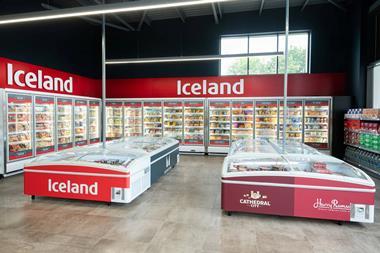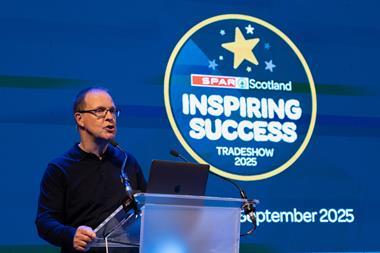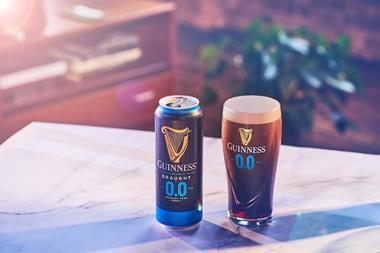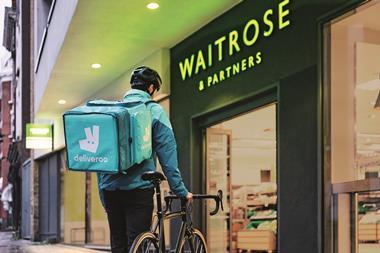Spar, Auchan and Metro have carved their way into Russia, but with local retailers sharpening their act, could other would-be entrants find themselves missing out on serious money? John Wood reports
Anyone stepping into one of Perekriostok’s Moscow hypermarkets will be put in mind of Asda. The size of the store, its layout and its product range, in fact everything except the number of SKUs - Perekriostok has over 35,000 on average compared to Asda’s 20,000 - seems to have been modelled on the Wal-Mart company.
It shouldn’t come as a surprise: former Asda chairman John Hardman was on its board from 2000 to 2002 and the consultant who worked on the project was former Asda head of retail operations Tim Conlon.
What is a surprise is that neither Wal-Mart nor Tesco have made a move yet on Russia despite having sent teams out to assess one of the fastest-growing markets in the world. Why are they holding back?
Since the crash of 1998, the Russian economy has seen a remarkable turnaround and is now growing at 7% to 8% a year. Many international retailers have been enticed to invest in the country’s two largest cities, Moscow and St Petersburg, in particular, by the promise of an emerging middle class and rocketing consumer spending. Consumers have a high percentage of disposable income compared to their European counterparts, and since the crash when many lost savings, most seem inclined to spend their money rather than save it.
And the potential for future growth is very good. Deborah Bronnert, economic and commercial counsellor at the British Embassy, says: “The question is not whether there will be another crash in Russia, but whether the country will fulfil its full potential.”
But Russia is not an easy place to invest. Natasha Zagvozdina, vice-president of research for analysts Renaissance Capital, warns that the Moscow market has become highly competitive with sites becoming scarce and land prices rocketing. If Tesco is considering its usual entry strategy, of buying a local retailer, it may find a shortage of takers, she suggests.
“It will be difficult to buy existing retailers. Most were set up in the last 10 years: the owners are still in their 30s and 40s and are making good profits. They are still ambitious to grow their businesses.”
One factor that might open them up to offers, however, is the difficulty of raising finance in Russia, she says, and some may consider selling a stake in their company to pay for expansion. But the best entry route for international companies wanting to break into the market is to buy greenfield sites and buy in expertise by hiring managers at existing retailers, she suggests.
Local government corruption, often cited as another major deterrent, is far less widespread than many outsiders believe, says Bronnert. “It is an issue, but if a company says it is not paying bribes, it can establish a reputation for not paying bribes and still do business here.”
Another insider adds: “Sometimes you will have to pay bribes, but there are rules, everyone has to pay the same, and no one will be left at a competitive disadvantage.”
One of the first international retailers to enter the market was Spar in 2000, which now has 15 stores in the Moscow area. Dmitriy Maslov, president of its franchise owner, was running a wholesale company when he applied to join Spar. He realised that growing local chains and international retailers moving into the market would put smaller retailers under pressure, and support from Spar would help them compete.
Maslov says it has taken time to build a track record to persuade retailers to join, and there have been problems because franchising is a relatively new concept in Russian retailing, but he is confident of adding another 10 stores this year.
French retailer Auchan has made one of the most dramatic entries into the Moscow market with two massive stores. The first, in August 2002, was a 172,000 sq ft hypermarket anchoring a 390,000 sq ft shopping centre housing 60 other stores, 12 cafés and restaurants and with parking for 2,700 cars.
And that was topped in December of the same year when it opened a 260,000 sq ft hypermarket at the Mega Mall on the outskirts of Moscow developed by Ikea. The stores have traffic jams around them on Saturdays due to the volume of shoppers.
Another major entrant into the Russian market is Metro Cash & Carry, which has invested $200m to develop five cash and carries in Moscow and two in St Petersburg. It also plans to open seven more this year, including its first stores in the regions (see panel overleaf). Its stores are only open to “professional” customers who must show evidence of running a business to qualify for membership, and anyone familiar with stores run by its British arm Makro Cash and Carry would be familiar with the product range (50:50 food and non-food) and layout.
Stephen Kreeger, purchasing director food, who joined Metro when it moved into Russia three years ago, says the company has helped change the market, particularly the logistics. “In the past there was less discipline, but we insisted on deliveries on certain days, at certain times and in certain quantities and we have rigorous quality standards. There is no large Russian supplier we do not work with and it’s amazing how quickly they have adapted.”
Metro has also recently announced plans to open two Real hypermarkets of 290,000 sq ft and 190,000 sq ft at a cost of $70m.
The international players that have taken the plunge are facing fierce competition from local retailers, some of which are stepping up their own expansion plans.
One company that intends to float is second largest retailer Perekriostok. It has already sold a 7.7% stake to Templeton Strategic Emerging Markets Fund, and aims to be the first Russian retailer to float on a Western stockmarket. The company operates more than 60 stores, including four hypermarkets, and turnover for 2003 was $450m. This year it aims to add 22-24 more stores and it intends to top 100 stores next year. Although most are in Moscow and St Petersburg, it is also moving into the regions in cities like Samara and Volgograd.
A British trend Perekriostok is keen to emulate is non-food growth. In its first 75,500 sq ft hypermarket in Moscow, it invited a local white goods retailer to take a 10,000 sq ft concession with its own tills. Lev Safronov, the chief of its international relations department, says it has taken lessons from that experience and set up its own white goods departments in later hypermarkets. Safronov says his company is also aware of the George phenomenon. It has a small selection of clothing although he admits that it is still an area it is getting to grips with.
The rest of the categories are much as would be expected in any British store but the number of SKUs is a surprise. Like many other Russian retailers, Perekriostok stocks a much greater number of variants of each product than British counterparts, with hypermarkets offering 35,000-40,000 SKUs and supermarkets stocking 20,000-25,000. Safronov says this is because they are catering for a variety of customers in a range of income groups so have to offer a variety of price points. With some suppliers struggling to maintain regular reliable deliveries, it also helps to have alternatives to fill gaps on shelf.
Pyaterochka is another fast-growing chain moving into the regions from St Petersburg and Moscow, although its neighbourhood discount format is targeted at less affluent consumers than many of the other retailers.
Its latest move is into Ekaterinburg where an existing retailer has taken it on as a franchise and already operates seven stores. Andrei Alfyorov deputy director of the Ekaterinburg chain, says it offers just 3,000-4,000 products in stores of about 5,000 sq ft and aims for its prices to be 15% cheaper than other local stores. He says he can undercut local rivals because of the tight product range, lower margins, and an efficient supply chain and automatic ordering using data from its EPoS systems.
So will Tesco and Wal-Mart join the fray? With so many strong local and international retailers established and fiercely contesting the market, Igor Serdyuk, publisher and editor in chief at b2b publisher Vitrina, warns their opportunity is slipping away.
But Natasha Zagvozdina believes that Wal-Mart, which has had meetings with Perekriostok, will make a move, and soon. She believes its entry would produce a big benefit to consumers helping to bring down prices and raise standards.
Tesco has had meetings with retailers and suppliers in Moscow but although it would seem to be a logical move considering its strong position in Eastern European markets such as Poland and Hungary, a spokesman says it has no plans to enter Russia.
Considering Tesco has confirmed its interest in entering China, Deborah Bronnert says the retailer may be overlooking a far better prospect.
She says: “Companies here are telling me their return on investment is even higher than in China. Most companies here are doing very well.”
With competition in Moscow hotting up, its retailers have been looking towards Russia’s regions for expansion.
Aleksei Kurlykov, the regional head for Ekaterinburg for developer Park House, says that Moscow and St Petersburg are already heading towards saturation in terms of shopping centres.
His company is concentrating on the 10 other cities that have a population of more than one million.
It has already built shopping/leisure centres of 516,000 sq ft and 579,000 sq ft in Samara and Volgograd with Perekriostok hypermarkets as anchor tenants and has started a 624,000 sq ft centre in Ekaterinburg, which will house a 70,000 sq ft Spar store.
Ikea is also planning shopping centres based on its Mega Mall in Moscow, which is anchored by an Auchan hypermarket.
Last month, it opened its first regional store, at Kazan, and is planning to build in several other cities including Ekaterinburg.
Inge Juliusson, the sales and marketing manager for Ikea Russia, says that it does not have an exclusive deal with Auchan.
Local retailers in Ekaterinburg, such as Valery Boubnov, general director of cash and carry/ supermarket operator Uniland and Svetlana Lyass, director of Zvyozdnyi supermarket, suggest high land prices and poorer margins than in Moscow would make it too expensive for outside companies to operate in their city.
But Nadezhda Shestakova at the regional ministry for trade, food and services, says they would welcome new competition.
British retailers may be conspicuous by their absence but there are plenty of familiar British brands on shelves, advertised on TV and with Russian offices.
Alison Forrestal has recenty taken charge of Diageo’s operation in Russia, the Baltics and the former Soviet Union, where its Johnnie Walker is the leading whisky brand.
She says red tape can be a nightmare, with masses of paperwork and sometimes long delays, especially when importing alcohol.
But with imported spirits sales growth of between 30% and 40% year-on-year it is well worth the frustration.
Diageo uses a local distribution specialist - Roust - but at Unilever, David Lowes, business director foods in Russia, is in charge of 12 distribution centres and four factories employing a total of 1,500.
The challenge is enormous, he says: “This is the largest country in the world. It covers 11 time zones and our distribution centre in Vladivostok is closer to San Francisco than it is to Moscow.”
The railway trucks it uses for distribution in Siberia need to be heated in winter and chilled in the summer.
Keeping pace with the fast developing market is yet another challenge, says Lowes. His team must carry out constant consumer research because tastes are changing so fast.
Despite the difficulties, the opportunities outweigh the problems, he says.
With operations such as Unilever’s third biggest tea business in the world and its fourth ranked mayonnaise business in Europe, Unilever is approaching E350m turnover in Russia with double digit growth and has moved into profit.
Looking to the regions...
British brands on Russian shelves
Anyone stepping into one of Perekriostok’s Moscow hypermarkets will be put in mind of Asda. The size of the store, its layout and its product range, in fact everything except the number of SKUs - Perekriostok has over 35,000 on average compared to Asda’s 20,000 - seems to have been modelled on the Wal-Mart company.
It shouldn’t come as a surprise: former Asda chairman John Hardman was on its board from 2000 to 2002 and the consultant who worked on the project was former Asda head of retail operations Tim Conlon.
What is a surprise is that neither Wal-Mart nor Tesco have made a move yet on Russia despite having sent teams out to assess one of the fastest-growing markets in the world. Why are they holding back?
Since the crash of 1998, the Russian economy has seen a remarkable turnaround and is now growing at 7% to 8% a year. Many international retailers have been enticed to invest in the country’s two largest cities, Moscow and St Petersburg, in particular, by the promise of an emerging middle class and rocketing consumer spending. Consumers have a high percentage of disposable income compared to their European counterparts, and since the crash when many lost savings, most seem inclined to spend their money rather than save it.
And the potential for future growth is very good. Deborah Bronnert, economic and commercial counsellor at the British Embassy, says: “The question is not whether there will be another crash in Russia, but whether the country will fulfil its full potential.”
But Russia is not an easy place to invest. Natasha Zagvozdina, vice-president of research for analysts Renaissance Capital, warns that the Moscow market has become highly competitive with sites becoming scarce and land prices rocketing. If Tesco is considering its usual entry strategy, of buying a local retailer, it may find a shortage of takers, she suggests.
“It will be difficult to buy existing retailers. Most were set up in the last 10 years: the owners are still in their 30s and 40s and are making good profits. They are still ambitious to grow their businesses.”
One factor that might open them up to offers, however, is the difficulty of raising finance in Russia, she says, and some may consider selling a stake in their company to pay for expansion. But the best entry route for international companies wanting to break into the market is to buy greenfield sites and buy in expertise by hiring managers at existing retailers, she suggests.
Local government corruption, often cited as another major deterrent, is far less widespread than many outsiders believe, says Bronnert. “It is an issue, but if a company says it is not paying bribes, it can establish a reputation for not paying bribes and still do business here.”
Another insider adds: “Sometimes you will have to pay bribes, but there are rules, everyone has to pay the same, and no one will be left at a competitive disadvantage.”
One of the first international retailers to enter the market was Spar in 2000, which now has 15 stores in the Moscow area. Dmitriy Maslov, president of its franchise owner, was running a wholesale company when he applied to join Spar. He realised that growing local chains and international retailers moving into the market would put smaller retailers under pressure, and support from Spar would help them compete.
Maslov says it has taken time to build a track record to persuade retailers to join, and there have been problems because franchising is a relatively new concept in Russian retailing, but he is confident of adding another 10 stores this year.
French retailer Auchan has made one of the most dramatic entries into the Moscow market with two massive stores. The first, in August 2002, was a 172,000 sq ft hypermarket anchoring a 390,000 sq ft shopping centre housing 60 other stores, 12 cafés and restaurants and with parking for 2,700 cars.
And that was topped in December of the same year when it opened a 260,000 sq ft hypermarket at the Mega Mall on the outskirts of Moscow developed by Ikea. The stores have traffic jams around them on Saturdays due to the volume of shoppers.
Another major entrant into the Russian market is Metro Cash & Carry, which has invested $200m to develop five cash and carries in Moscow and two in St Petersburg. It also plans to open seven more this year, including its first stores in the regions (see panel overleaf). Its stores are only open to “professional” customers who must show evidence of running a business to qualify for membership, and anyone familiar with stores run by its British arm Makro Cash and Carry would be familiar with the product range (50:50 food and non-food) and layout.
Stephen Kreeger, purchasing director food, who joined Metro when it moved into Russia three years ago, says the company has helped change the market, particularly the logistics. “In the past there was less discipline, but we insisted on deliveries on certain days, at certain times and in certain quantities and we have rigorous quality standards. There is no large Russian supplier we do not work with and it’s amazing how quickly they have adapted.”
Metro has also recently announced plans to open two Real hypermarkets of 290,000 sq ft and 190,000 sq ft at a cost of $70m.
The international players that have taken the plunge are facing fierce competition from local retailers, some of which are stepping up their own expansion plans.
One company that intends to float is second largest retailer Perekriostok. It has already sold a 7.7% stake to Templeton Strategic Emerging Markets Fund, and aims to be the first Russian retailer to float on a Western stockmarket. The company operates more than 60 stores, including four hypermarkets, and turnover for 2003 was $450m. This year it aims to add 22-24 more stores and it intends to top 100 stores next year. Although most are in Moscow and St Petersburg, it is also moving into the regions in cities like Samara and Volgograd.
A British trend Perekriostok is keen to emulate is non-food growth. In its first 75,500 sq ft hypermarket in Moscow, it invited a local white goods retailer to take a 10,000 sq ft concession with its own tills. Lev Safronov, the chief of its international relations department, says it has taken lessons from that experience and set up its own white goods departments in later hypermarkets. Safronov says his company is also aware of the George phenomenon. It has a small selection of clothing although he admits that it is still an area it is getting to grips with.
The rest of the categories are much as would be expected in any British store but the number of SKUs is a surprise. Like many other Russian retailers, Perekriostok stocks a much greater number of variants of each product than British counterparts, with hypermarkets offering 35,000-40,000 SKUs and supermarkets stocking 20,000-25,000. Safronov says this is because they are catering for a variety of customers in a range of income groups so have to offer a variety of price points. With some suppliers struggling to maintain regular reliable deliveries, it also helps to have alternatives to fill gaps on shelf.
Pyaterochka is another fast-growing chain moving into the regions from St Petersburg and Moscow, although its neighbourhood discount format is targeted at less affluent consumers than many of the other retailers.
Its latest move is into Ekaterinburg where an existing retailer has taken it on as a franchise and already operates seven stores. Andrei Alfyorov deputy director of the Ekaterinburg chain, says it offers just 3,000-4,000 products in stores of about 5,000 sq ft and aims for its prices to be 15% cheaper than other local stores. He says he can undercut local rivals because of the tight product range, lower margins, and an efficient supply chain and automatic ordering using data from its EPoS systems.
So will Tesco and Wal-Mart join the fray? With so many strong local and international retailers established and fiercely contesting the market, Igor Serdyuk, publisher and editor in chief at b2b publisher Vitrina, warns their opportunity is slipping away.
But Natasha Zagvozdina believes that Wal-Mart, which has had meetings with Perekriostok, will make a move, and soon. She believes its entry would produce a big benefit to consumers helping to bring down prices and raise standards.
Tesco has had meetings with retailers and suppliers in Moscow but although it would seem to be a logical move considering its strong position in Eastern European markets such as Poland and Hungary, a spokesman says it has no plans to enter Russia.
Considering Tesco has confirmed its interest in entering China, Deborah Bronnert says the retailer may be overlooking a far better prospect.
She says: “Companies here are telling me their return on investment is even higher than in China. Most companies here are doing very well.”
With competition in Moscow hotting up, its retailers have been looking towards Russia’s regions for expansion.
Aleksei Kurlykov, the regional head for Ekaterinburg for developer Park House, says that Moscow and St Petersburg are already heading towards saturation in terms of shopping centres.
His company is concentrating on the 10 other cities that have a population of more than one million.
It has already built shopping/leisure centres of 516,000 sq ft and 579,000 sq ft in Samara and Volgograd with Perekriostok hypermarkets as anchor tenants and has started a 624,000 sq ft centre in Ekaterinburg, which will house a 70,000 sq ft Spar store.
Ikea is also planning shopping centres based on its Mega Mall in Moscow, which is anchored by an Auchan hypermarket.
Last month, it opened its first regional store, at Kazan, and is planning to build in several other cities including Ekaterinburg.
Inge Juliusson, the sales and marketing manager for Ikea Russia, says that it does not have an exclusive deal with Auchan.
Local retailers in Ekaterinburg, such as Valery Boubnov, general director of cash and carry/ supermarket operator Uniland and Svetlana Lyass, director of Zvyozdnyi supermarket, suggest high land prices and poorer margins than in Moscow would make it too expensive for outside companies to operate in their city.
But Nadezhda Shestakova at the regional ministry for trade, food and services, says they would welcome new competition.
British retailers may be conspicuous by their absence but there are plenty of familiar British brands on shelves, advertised on TV and with Russian offices.
Alison Forrestal has recenty taken charge of Diageo’s operation in Russia, the Baltics and the former Soviet Union, where its Johnnie Walker is the leading whisky brand.
She says red tape can be a nightmare, with masses of paperwork and sometimes long delays, especially when importing alcohol.
But with imported spirits sales growth of between 30% and 40% year-on-year it is well worth the frustration.
Diageo uses a local distribution specialist - Roust - but at Unilever, David Lowes, business director foods in Russia, is in charge of 12 distribution centres and four factories employing a total of 1,500.
The challenge is enormous, he says: “This is the largest country in the world. It covers 11 time zones and our distribution centre in Vladivostok is closer to San Francisco than it is to Moscow.”
The railway trucks it uses for distribution in Siberia need to be heated in winter and chilled in the summer.
Keeping pace with the fast developing market is yet another challenge, says Lowes. His team must carry out constant consumer research because tastes are changing so fast.
Despite the difficulties, the opportunities outweigh the problems, he says.
With operations such as Unilever’s third biggest tea business in the world and its fourth ranked mayonnaise business in Europe, Unilever is approaching E350m turnover in Russia with double digit growth and has moved into profit.
Looking to the regions...
British brands on Russian shelves














No comments yet